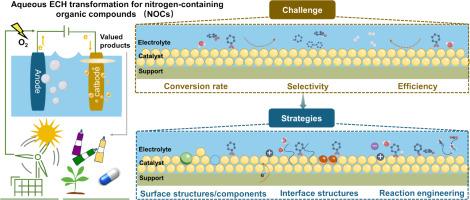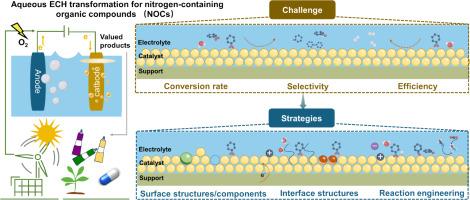含氮有机化合物的水溶液电化学加氢
IF 23.5
1区 化学
Q1 CHEMISTRY, INORGANIC & NUCLEAR
引用次数: 0
摘要
含氮有机化合物加氢作为实现可持续人工氮循环的有效途径,被广泛应用于化工、医药和能源等领域。传统化石燃料驱动的高压氢热化学加氢是一个能源密集型的碳排放过程。相比之下,水溶液电化学加氢(ECH)提供了一种更环保的替代方案,在环境条件下使用水作为氢源,利用阴极电位代替热量和氢输入。国有石油公司的ECH提供了一种在环境条件下将可再生能源转化为增值含氮产品的有效方法。然而,诸如低转化率、析氢竞争以及ECH过程的复杂性等挑战显著影响了加氢催化剂的活性和转化效率,特别是降低了对目标含氮分子的选择性。研究选择性ECH可以减少与传统化学过程相关的副产品和废物排放,推进绿色化学技术,并扩大增值含氮有机产品的市场。本文综述了近年来具有代表性的NOCs选择性ECH的研究进展,包括催化剂表面质子活化的机理和活性指标。此外,结合原位表征技术探测反应中间体和理论计算阐明构效关系,提出了三种策略(结构/组分优化、界面工程和反应工程)来提高ECH将noc转化为含氮有机增值产品的选择性。这些方法共同研究和优化了催化剂-电解质界面上的质子活化、电子转移和底物加氢途径,旨在将noc升级为增值产品。探测反应中间体的表征技术和澄清构效关系的理论计算。这些方法共同研究和优化了催化剂-电解质界面上的质子活化、电子转移和底物加氢途径,最终旨在将noc升级为增值产品。最后,综述了有机含氮原料高效ECH催化剂设计面临的挑战和未来发展方向,重点讨论了该技术在人工氮循环及其大规模实施中的应用前景。本文章由计算机程序翻译,如有差异,请以英文原文为准。


Aqueous electrochemical hydrogenation of nitrogen-containing organic compounds
Hydrogenation of nitrogen-containing organic compounds (NOCs) are widely used in chemical industry, medicine and energy as an effective approach to achieving a sustainable artificial nitrogen cycle. Conventional fossil-fuel-driven thermochemical hydrogenation of high-pressure hydrogen is an energy-intensive carbon emission process. In contrast, aqueous electrochemical hydrogenation (ECH) offers a greener alternative by using water as a hydrogen source under ambient conditions, utilizing cathode potential instead of heat and hydrogen inputs. ECH of NOCs presents a potent method to convert renewable energy into value-added nitrogen-containing products under environmental conditions. However, challenges such as low conversion rates, competition from hydrogen evolution, and the complexity of the ECH process significantly impact the activity and conversion efficiency of hydrogenation catalysts, particularly reducing the selectivity for the target nitrogen-containing molecules. Investigating selective ECH can mitigate by-product and waste emissions associated with traditional chemical processes, advance green chemical technology, and expand the market for value-added nitrogen-containing organic products. This review summarizes the recent research progress on the selective ECH of representative NOCs, covering the underlying mechanisms and activity indicators related to proton activation on catalysts surface. Additionally, three strategies (structure/component optimization, interface engineering and reaction engineering) were proposed to enhance the selectivity of ECH to upgrade NOCs into nitrogen-containing organic value-added products, combined with in-situ characterization techniques for probing reaction intermediates and theoretical calculations to clarify structure-activity relationships. These approaches collectively enable the investigation and optimization of proton activation, electron transfer, and substrate hydrogenation pathways at the catalyst-electrolyte interface, aiming to upgrade NOCs into value-added products. characterization techniques for probing reaction intermediates and theoretical calculations to clarify structure-activity relationships. These approaches collectively enable the investigation and optimization of proton activation, electron transfer, and substrate hydrogenation pathways at the catalyst-electrolyte interface, ultimately aiming to upgrade NOCs into value-added products. Finally, the review discusses the challenges and future directions in designing high-efficiency ECH catalysts for organic nitrogen-containing feedstocks, with a focus on improving the application prospects of this technology in the artificial nitrogen cycle and its large-scale implementation.
求助全文
通过发布文献求助,成功后即可免费获取论文全文。
去求助
来源期刊

Coordination Chemistry Reviews
化学-无机化学与核化学
CiteScore
34.30
自引率
5.30%
发文量
457
审稿时长
54 days
期刊介绍:
Coordination Chemistry Reviews offers rapid publication of review articles on current and significant topics in coordination chemistry, encompassing organometallic, supramolecular, theoretical, and bioinorganic chemistry. It also covers catalysis, materials chemistry, and metal-organic frameworks from a coordination chemistry perspective. Reviews summarize recent developments or discuss specific techniques, welcoming contributions from both established and emerging researchers.
The journal releases special issues on timely subjects, including those featuring contributions from specific regions or conferences. Occasional full-length book articles are also featured. Additionally, special volumes cover annual reviews of main group chemistry, transition metal group chemistry, and organometallic chemistry. These comprehensive reviews are vital resources for those engaged in coordination chemistry, further establishing Coordination Chemistry Reviews as a hub for insightful surveys in inorganic and physical inorganic chemistry.
 求助内容:
求助内容: 应助结果提醒方式:
应助结果提醒方式:


